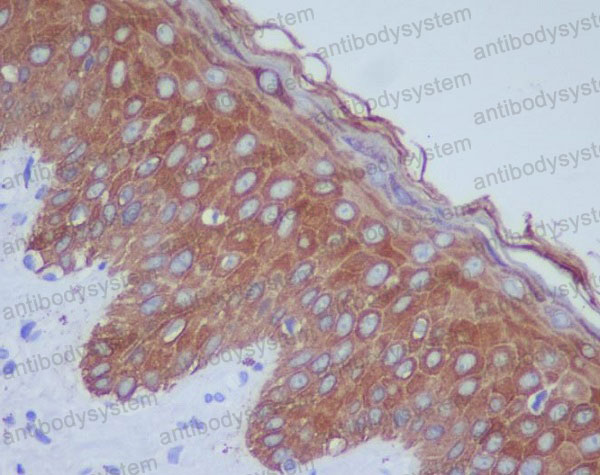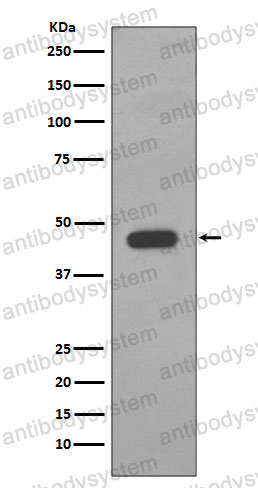Catalog No.
RHB98002
Species reactivity
Human
Host species
Rabbit
Isotype
IgG
Clonality
Monoclonal
Tested applications
FCM: 1:20-1:100, IF: 1:50-1:200, IHC: 1:100-1:200, IP: 1:20-1:50, WB: 1:1000-1:2000
Target
Keratin-14, K14, CK-14, Cytokeratin-14, KRT14, Keratin, type I cytoskeletal 14
Concentration
1 mg/ml
Endotoxin level
Please contact with the lab for this information.
Purity
>95% by SDS-PAGE.
Purification
Protein A/G purified from cell culture supernatant.
Accession
P02533
Applications
FCM, IF, IHC, IP, WB
Form
Liquid
Storage buffer
0.01M PBS, pH 7.4, 0.05% BSA, 50% Glycerol, 0.05% Sodium azide.
Stability and Storage
Use a manual defrost freezer and avoid repeated freeze thaw cycles. Store at 4 ℃ for frequent use. Store at -20 ℃ for twelve months from the date of receipt.
Clone ID
R1H89
Deciphering the Molecular Landscape of Urothelial Carcinoma: Immunohistochemistry-based Subtyping Using 4 Easily Available Antibodies for Cost-effective Stratification., PMID:40497570
Mesenchymal stem cells from perinatal tissues promote diabetic wound healing via PI3K/AKT activation., PMID:39923118
IgG autoantibodies in bullous pemphigoid directly induce a pathogenic MyD88-dependent pro-inflammatory response in keratinocytes., PMID:39569141
Candidate proteins interacting with cytoskeleton in cells from the basal airway epithelium in vitro., PMID:39139811
Nanoscopic and Functional Characterization of Keratinocyte-Originating Exosomes in the Wound Fluid of Non-Diabetic and Diabetic Chronic Wound Patients., PMID:38282661
Study of pathological processes of meibomian gland dysfunction by in vitro culture airlifting conditions., PMID:37216482
Epithelial cell-expressed type II IL-4 receptor mediates eosinophilic esophagitis., PMID:36070083
Immunohistochemical Assays for Bladder Cancer Molecular Subtyping: Optimizing Parsimony and Performance of Lund Taxonomy Classifiers., PMID:35437049
CCL17-CCR4 axis contributes to the onset of vitiligo in mice., PMID:34077992
Efficacy of neoadjuvant atezolizumab treatment in patients with advanced urothelial bladder cancer according to the BASQ classification: a study protocol for an open-label, two-cohort, phase II trial., PMID:33060077
Tumor-Resident Stromal Cells Promote Breast Cancer Invasion through Regulation of the Basal Phenotype., PMID:32868298
Keratinocyte-specific deletion of SHARPIN induces atopic dermatitis-like inflammation in mice., PMID:32687504
Autophagy-based unconventional secretion of HMGB1 by keratinocytes plays a pivotal role in psoriatic skin inflammation., PMID:32019420
Keratinocyte growth factor (KGF) induces stem/progenitor cell growth in middle ear mucosa., PMID:31614241
Clinical outcomes of muscle invasive bladder Cancer according to the BASQ classification., PMID:31500577
Gene Expression Profiling Reveals Distinct Molecular Subtypes of Esophageal Squamous Cell Carcinoma in Asian Populations., PMID:31048097
Mesenchymal stem cells differentiate into keratinocytes and express epidermal kallikreins: Towards an in vitro model of human epidermis., PMID:30891818
Deletion of Interleukin-4 Receptor Alpha-Responsive Keratinocytes in BALB/c Mice Does Not Alter Susceptibility to Cutaneous Leishmaniasis., PMID:30275010
Burnlike scars: A sign suggestive of KLHL24-related epidermolysis bullosa simplex., PMID:29574966
Regulation of keratin 5/14 intermediate filaments by CDK1, Aurora-B, and Rho-kinase., PMID:29518391
Quantitative, in situ analysis of mRNAs and proteins with subcellular resolution., PMID:29184166
γ-H2AX formation in the urinary bladder of rats treated with two norharman derivatives obtained from o-toluidine and aniline., PMID:29143974
SOX2 Is a Marker for Stem-like Tumor Cells in Bladder Cancer., PMID:28793245
Prdm1 Regulates Thymic Epithelial Function To Prevent Autoimmunity., PMID:28701508
Effectiveness of computer-aided diagnosis (CADx) of breast pathology using immunohistochemistry results of core needle biopsy samples for synaptophysin, oestrogen receptor and CK14/p63 for classification of epithelial proliferative lesions of the breast., PMID:28630050
Dataset on gene expression profiling of multiple murine hair follicle populations., PMID:27672671
Detection and quantification of epithelial progenitor cell populations in human healthy and IPF lungs., PMID:27423691
Isolating RNA from precursor and mature melanocytes from human vitiligo and normal skin using laser capture microdissection., PMID:27193292
Characterization of the myoepithelial cells in the major salivary glands of the fruit bat Artibeus jamaicensis., PMID:27168421
Epithelial cell migration requires the interaction between the vimentin and keratin intermediate filaments., PMID:27072292
A unique lineage gives rise to the meibomian gland., PMID:26957900
Breast cancer resistance protein identifies clonogenic keratinocytes in human interfollicular epidermis., PMID:25881149
CD14-expressing cancer cells establish the inflammatory and proliferative tumor microenvironment in bladder cancer., PMID:25825750
Keratolysis exfoliativa (dyshidrosis lamellosa sicca): a distinct peeling entity., PMID:23039091
Verrucous carcinoma in epidermolysis bullosa simplex is possibly associated with a novel mutation in the keratin 5 gene., PMID:22639907
Extensive acantholysis as the major histological feature of a severe case of Dowling Meara-epidermolysis bullosa simplex: a reappraisal of acantholysis in the newborn., PMID:21856558
The role of fibroblast growth factors on the differentiation of vaginal epithelium of neonatal mice., PMID:21530063
Mutations in KRT5 and KRT14 cause epidermolysis bullosa simplex in 75% of the patients., PMID:21375516
Caged fluorescent haptens reveal the generation of cryptic epitopes in allergic contact dermatitis., PMID:21228815
Erratum to "Neutrophil-dominant psoriasis-like skin inflammation induced by epidermal-specific expression of Raf in mice" [J. Dermatol. Sci. 58 (2010) 28-35]., PMID:20578288
Autoantibodies in scurfy mice and IPEX patients recognize keratin 14., PMID:20147963
VCAM-1 blockade delays disease onset, reduces disease severity and inflammatory cells in an atopic dermatitis model., PMID:20065994
Clinical heterogeneity in recessive epidermolysis bullosa due to mutations in the keratin 14 gene, KRT14., PMID:18713255
The properties of a mammary gland cancer stem cell., PMID:17566110
Existence of small slow-cycling Langerhans cells in the limbal basal epithelium that express ABCG2., PMID:17254566
Ductal carcinoma in situ with basal-like phenotype: a possible precursor to invasive basal-like breast cancer., PMID:16528377
The disease progression in the keratin 14 IL-4-transgenic mouse model of atopic dermatitis parallels the up-regulation of B cell activation molecules, proliferation and surface and serum IgE., PMID:16178852
Carcinoma ex pleomorphic adenoma (CXPA): immunoprofile of the cells involved in carcinomatous progression., PMID:15910594
Hair follicle stem cells in the lower bulge form the secondary germ, a biochemically distinct but functionally equivalent progenitor cell population, at the termination of catagen., PMID:15617565
Specific deletion of focal adhesion kinase suppresses tumor formation and blocks malignant progression., PMID:15601818


